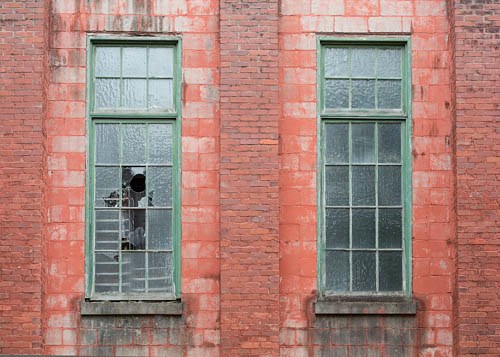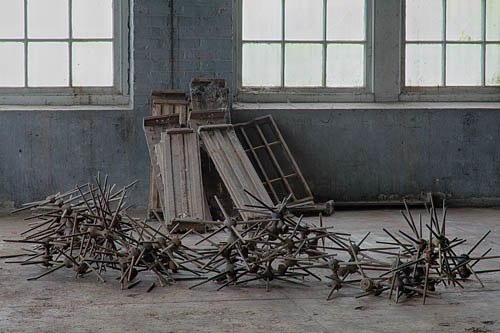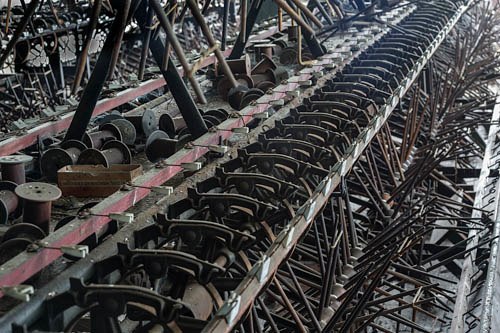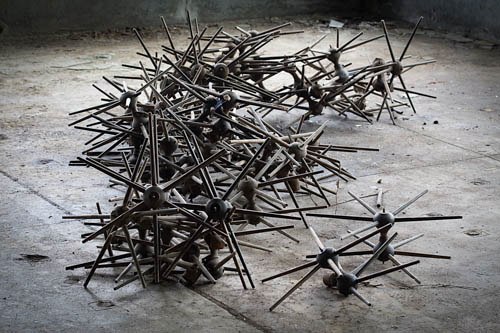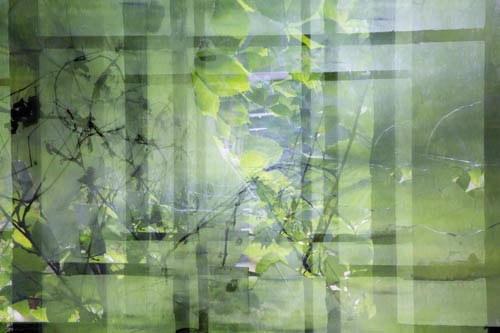MemoryStringer

Lonaconing Silk Mill
As nature photographers -- mainly, birds and butterflies, with assorted bugs, beasts and blossoms -- we had been looking forward to our trip to Lonaconing Silk Mill for months. We would be photographing something new: architecture! And something old: old architecture!
The silk mill, built in 1907 and used more or less continuously until 1957, was hanging on by, appropriately, a thread. At one time the mill provided jobs to more than 300 people, many of them the wives of coal miners, but labor disputes led to strikes and the mill’s eventual closing. It stands today much the way it looked when workers walked off the job, except for a few broken windows, some plastic buckets catching rain water, and some antique objects that visiting photographers had arranged for their shots.
Purchased by Herb Crawford in 1978, the mill did not go back into business as he’d been told, and as a retired teacher he had no money to put into much-needed repairs, the leaking roof being the most pressing and obvious. Preservationists love the place and call for its salvation, but Herb is not a not-for-profit, at least not formally, and so grant money is largely unavailable. He was offered $400,000 by an architectural salvage company a few years back, but he did not want to see the historic site cleaned out and then leveled. It’s a piece of history. As photographers, we wanted to help preserve it -- digitally, at least. And we felt OK that a chunk of the fee we were paying to Denise Ippolito, the photographer leading our session, was going to Herb and thus, indirectly, to the building. Herb told me that photo tours were about his only income to put up against the expenses. Imagine the fire insurance . . ..
I was delighted that we did not get lost on our way to our motel in Frostburg, a few miles from Lonaconing, though we did inadvertently take an alternate route that veered into West Virginia, adding about 30 minutes to our travels. Make that an hour when you add in the time spent stopped on the Interstate waiting for an accident to clear.
I thought that photographing architecture would be easy. After all, the building was unlikely to fly away when it sensed my shadow. And we’d seen online all the historic and picturesque machinery, tools, and specialized silk mill gear. I figured I’d go in, find cool stuff, get a good angle, and snap the picture. Piece of cake!
What I didn’t figure on was that we’d be taking pictures in the dark -- except for the glare of the windows. Nobody was using a flash. That meant long exposures, and the small apertures needed for greater depth of focus meant even longer exposures. I was hoping that, if the building did collapse, I would capture it all, as I died, in what Arthur Morris might call a “pleasing blur.”
No, I had to learn for maybe the hundredth time that photographers don’t take pictures: they (we?) make them.
And I had to learn for the first time that sometimes you can’t do it all in the camera. Sometimes you had to use a technique that I’d always thought of as cheating: HDR (which, for you non-photographers, stands for “Helps Difficult Exposures”). I knew I could do it in my new camera, and I knew that Kim’s fancy NIK software could do it, but I was struggling so much to get sharp pictures with good exposures that I figured I’d postpone learning about NIK and Photoshop until my next reincarnation (if I came back as a photographer). But Denise and some of the real photographers sharing their images over pizza on Friday night said that their images often looked like crap until they merged the different exposures using HDR. So I figured that there was hope for my crappy images.
Kim convinced a somewhat skeptical me to shoot all of our shots on Saturday morning using three bracketed exposures. And I did. My camera showed me a JPEG version of what I shot. (JPEG stands for “Just Pray Everything’s Good.”) That was enough to motivate me, when I got home, to purchase my own NIK software (actually I snatched it off of Kim’s account), download instructions from the Internet, and use it to merge most of my shots using HDR.
Meanwhile, back at the mill, Kim and I were fairly discouraged by the over- and underexposed shots we were seeing on the back of our cameras. “Just wait,” the experienced photographers had told us. And I’m glad we did.
We actually had to wait a little longer than we expected. On the drive home we saw a flashing sign on the Ohio Turnpike warning of delays due to construction and suggesting that we find an alternate route. Kim pointed out the sign to me and mentioned an approaching exit leading to a non-expressway home. But I knew better.
Ten minutes later we were crawling along at 3 miles per hour. An hour later we were up to 4. Engineers reading this: Can’t all you smart people figure out how to merge three lanes into two without making me late for dinner?
For those “readers” who skipped the text to look at the pictures, here are a couple more:
Monday, August 19, 2013

